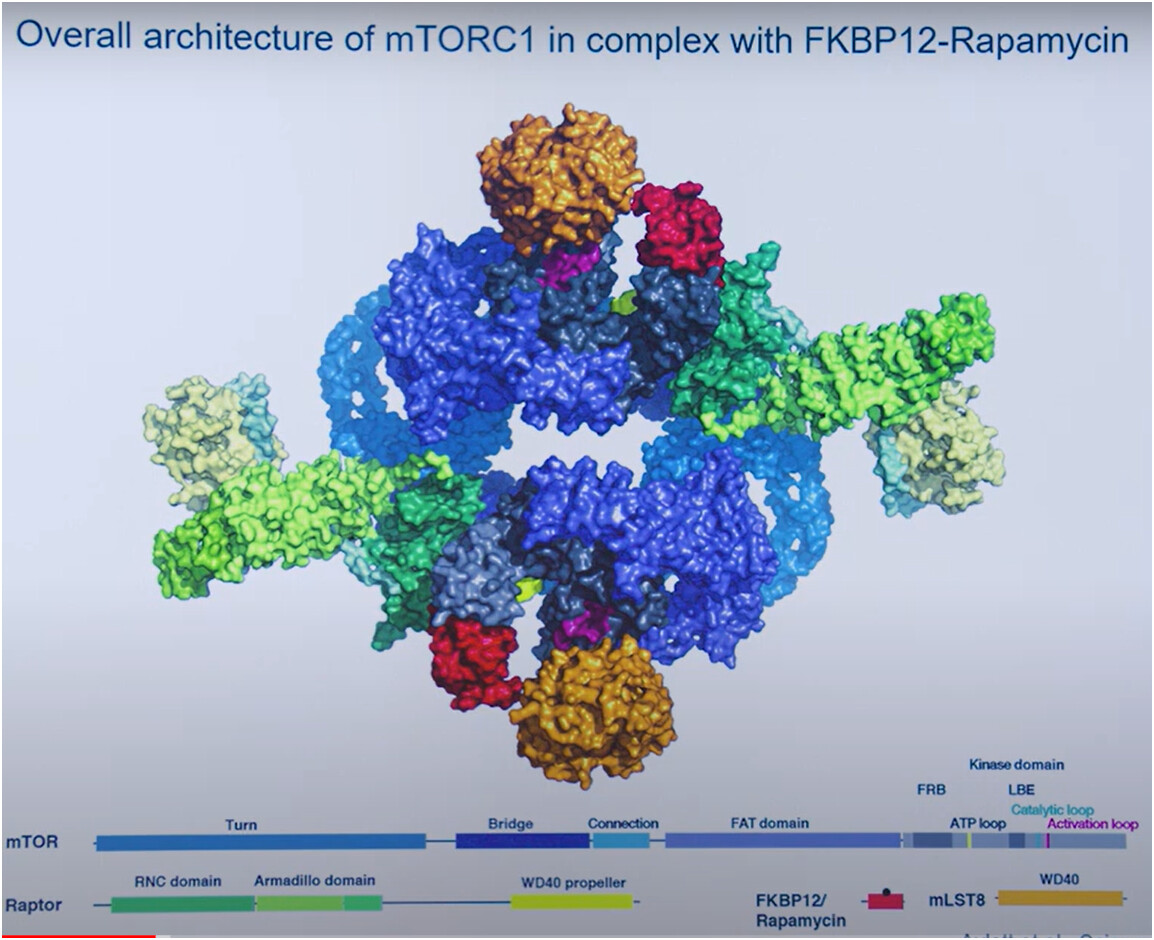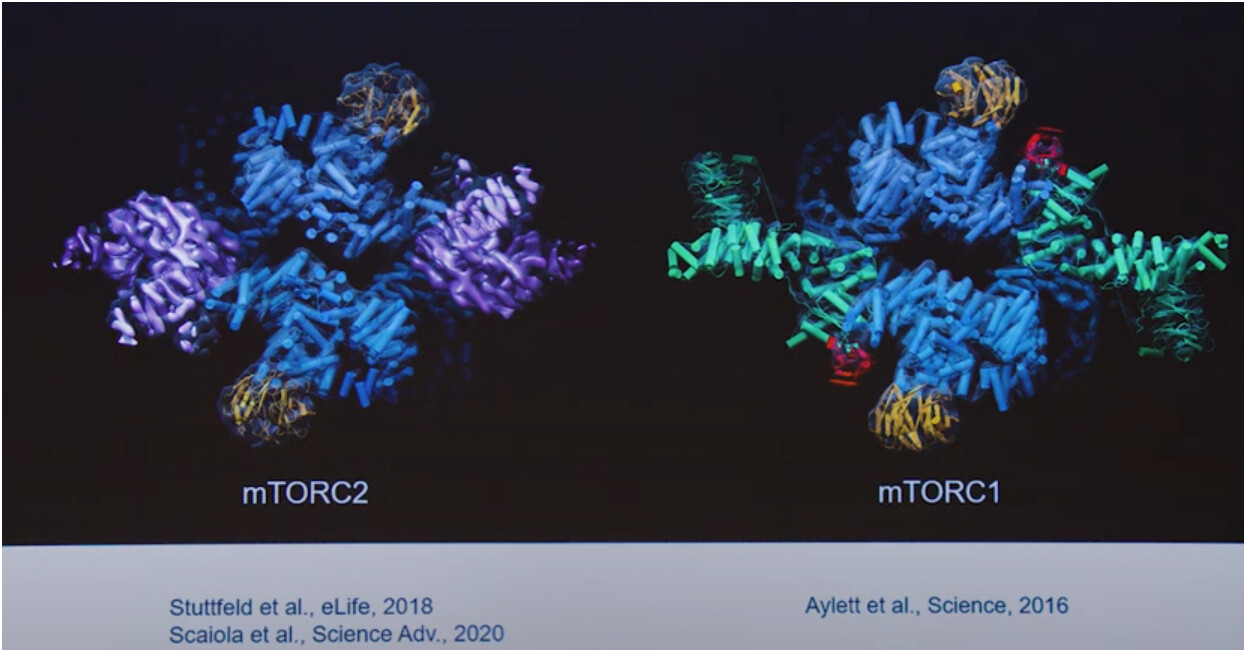I’m trying to find a straight forward succinct way of explaining the mechanism of Rapamycin. If someone came to you, and they knew nothing about Rapamycin, how would explain how Rapamycin leads to extended lifespan and/or health span?
Chatgpt is your friend.
" Rapamycin extends lifespan by inhibiting a protein complex called mTOR (mechanistic Target of Rapamycin). mTOR is a key regulator of cell growth, metabolism, and aging. When mTOR activity is reduced, as happens with rapamycin, the body shifts towards cellular maintenance and repair rather than growth and reproduction. This promotes several beneficial effects:
- Autophagy: Rapamycin increases autophagy, the process by which cells clear out damaged components, reducing cellular stress and promoting longevity.
- Reduced inflammation: Lower mTOR activity decreases chronic inflammation, which is linked to aging and age-related diseases.
- Improved metabolic function: It can enhance insulin sensitivity and reduce the risks of metabolic disorders like diabetes.
These combined effects help slow down the aging process, potentially leading to longer, healthier lives in various organisms."
I tell people that rapamycin stimulates autophagy in immune cells which “rejuvenates” its function resulting better clearing out of senescent cells which lowers chronic inflammation which drives many other benefits. I hope that is roughly correct.
I have personally experienced several immune improvements:
- elimination of allergies
- less joint pain after exercise (fully eliminated after a round of FMD)
- almost no illness any longer despite school age children in house (who are sick a lot).
It is a good addition to my program even if I get no other benefits (ie longevity).
I’m so glad you asked this! If not in bad form, may I piggyback on your post.
I’ve been wanting to ask which video and/or podcast would you recommend I share with a loved one to teach them about rapamycin and hopefull encourage them to become interested?
OK, sorry, I couldn’t resist, but you can always show the graph above and say that rapamycin very basically erases all the network by hitting mTOR at the heart. An acute subministration kills mTORC1, a chronic subministration kills both mTORC1 & 2. I found a graph more for beginners, showing the blow from rapamycin (in red).
Does that explain why it’s beneficial?
Even if no longevity benefit, I’d say those effects would increase health span significantly.
Would it be fair to say that the action of Rapamycin by itself is not the whole answer? If we blocked mtor1 permanently that would be harmful. It the action of Rapamycin followed by its absence and restoring mtor that results in benefits?
A top-down perspective:
Rapamycin = improving the “signal to noise ratio” of immune responses
??
This abstract suggests the key is activating the DNA damage response and increasing genome integrity. Maybe the much-discussed autophagy is destruction and recycling of cells with damaged DNA. One could imagine that overactive mTOR has the body laying more and more bricks in a wall, ignoring decaying bricks, and intermittent rapamycin allows for repointing and replacement of degraded bricks.
I would say no, because don’t they give every day at the ITP? I guess a mouse day is more than a human day, but still I think a continuous drip still works.
@KarlT , I confess that in the past I’ve been fascinated by mTor, consulting all manner of graphs and listening to the interviews and presentations of David Sabatini, the man who discovered this protein.
As much as I understand the mechanism, this is what the latest graph elucidates. I hope other members will intervene to correct me if I’m imprecise in some details.
The hit (dephosphorylation) from rapamycin interrupts, or maybe drastically dims all downstream signals from mTorc1, resulting in:
1-Less or no anabolic cell growth and proliferation
2-More autophagy.
This in the context of intermittent administration would last until the concentration of Rapamycin in the blood is enough to keep a level of dephosphorylation/dimming.
How long? Some members here have kept track of blood levels after a specific dosage, I don’t remember how long exactly the effect lasts, 2-3 days?
So after a couple of days the situation is restored to a hopefully healthy balance of anabolic cell growth and proliferation and autophagy, according to the natural cycles of activity of this masterswitch of cellular metabolism.
Please note that, according to David Sabatini, mTor does not get chronically overstimulated by upstream signaling (like for example excessive food or growth factors), unless some neoplastic pathology (cancer) occurs.
Last, if the use of rapamycin becomes chronic like in organ transplants, mTOR complex 2 is hit, which impinges negatively upon cytoskeleton organization and cell survival, but to tell the truth I’m not familiar with these effects…
I talk about Rapamycin a lot. I give speeches to my local Toastmasters Club about Rapamycin. I always start with “The Story of Mtor”.
That story goes like this; “inside just about every cell of your body is a master control switch for one of the most important things your cells can do, GROW! By growth I don’t mean bigger, I mean from 1 to 2. Cellular grown is cellular division. This cellular growth is how you go from 1 cell, 1/2 from you mom and 1/2 from your dad to the AMAZING 30 plus trillion cell person you saw in the mirror this morning.
MTOR drives this growth when it senses energy and nutrition, and in cellular speak that’s glucose or insulin and a few other things. Rapid cellular grow is really important when you’re young and growing, but not so much when you’re older. In fact, we have a term for it.……. Inflammaging.
Rapamycin, like a key in a lock turns off Mtor. Even when glucose or insulin are present. That’s the one thing Rapamycin does…….but, the effects are remarkable! The life spans in every animal test performed, are longer with Rapamycin!”
After “The Story of Mtor” it’s dealers choice of what to explain next. In my experience folks can handle autophagy (house cleaning), ok but Senecense and Quiescence are challenging. It helps to have simple picture-based slides when explaining those.
I hope this helps, I love talking about Rapamycin!
The mechanistic target of rapamycin (mTOR) is an atypical serine/threonine kinase that is present in two distinct complexes. The first, mTOR complex 1 (mTORC1), is composed of mTOR, Raptor, GβL, and DEPTOR and is inhibited by rapamycin. It is a master growth regulator that senses and integrates diverse nutritional and environmental cues, including growth factors, energy levels, cellular stress, and amino acids. It couples these signals to the promotion of cellular growth by phosphorylating substrates that potentiate anabolic processes such as mRNA translation and lipid synthesis, or limit catabolic processes such as autophagy. The small GTPase Rheb, in its GTP-bound state, is a necessary and potent stimulator of mTORC1 kinase activity, which is negatively regulated by its GAP, the tuberous sclerosis heterodimer TSC1/2. Most upstream inputs are funneled through Akt and TSC1/2 to regulate the nucleotide-loading state of Rheb. In contrast, amino acids signal to mTORC1 independently of the PI3K/Akt axis to promote the translocation of mTORC1 to the lysosomal surface where it can become activated upon contact with Rheb. This process is mediated by the coordinated actions of multiple complexes, notably the v-ATPase, Ragulator, the Rag GTPases, and GATOR1/2. The second complex, mTOR complex 2 (mTORC2), is composed of mTOR, Rictor, GβL, Sin1, PRR5/Protor-1, and DEPTOR. mTORC2 promotes cellular survival by activating Akt, regulates cytoskeletal dynamics by activating PKCα, and controls ion transport and growth via SGK1 phosphorylation. Aberrant mTOR signaling is involved in many disease states including cancer, cardiovascular disease, and diabetes.
mTOR Pathway | Cell Signaling Technology.
Selected Reviews:
- Dowling RJ, Topisirovic I, Fonseca BD, Sonenberg N (2010) Dissecting the role of mTOR: lessons from mTOR inhibitors. Biochim. Biophys. Acta 1804(3), 433–9.
- Dunlop EA, Tee AR (2009) Mammalian target of rapamycin complex 1: signalling inputs, substrates and feedback mechanisms. Cell. Signal. 21(6), 827–35.
- Hoeffer CA, Klann E (2010) mTOR signaling: at the crossroads of plasticity, memory and disease. Trends Neurosci. 33(2), 67–75.
- Laplante M, Sabatini DM (2013) Regulation of mTORC1 and its impact on gene expression at a glance. J. Cell. Sci. 126(Pt 8), 1713–9.
- Laplante M, Sabatini DM (2012) mTOR signaling in growth control and disease. Cell 149(2), 274–93.
- Neufeld TP (2010) TOR-dependent control of autophagy: biting the hand that feeds. Curr. Opin. Cell Biol. 22(2), 157–68.
- Zoncu R, Efeyan A, Sabatini DM (2011) mTOR: from growth signal integration to cancer, diabetes and ageing. Nat. Rev. Mol. Cell Biol. 12(1), 21–35.
If Rapamycin only stopped mtor1 and had no impact on mtor2, should it be taken every day or continue with once a week? Is turning mtor1 back on just as important?
No, every day administration would cause the on-label effect of immunosuppression, evidently mTOR in the immune system is very sensible to Rapamycin; the intermittent administration is at the base of the seminal experiment of Joan Mannick, who had this intuition and observed in the clinical trial an immuno activation subsequent to the intermittent inhibition of mTOR.
Returning to the natural activity of mTOR is vital, we cannot live in a permanent state of prevailing autophagy and catabolism.
The fast mimicking diet of Valter Longo is an example of intermittent inhibition of mTOR, and the reactivation of this complex by proper refeeding is a necessary phase of the technique.
It would be interesting to open a thread to discuss the analogies and differences between Rapamycin and Longo’s FMD, they hit mTOR in similar, but not identical ways.
This clip is very relevant to the original question posed, the answer is given by the discoverer of mTOR himself, David Sabatini, who compares mTOR to the Central Processing Unit of a computer. He also clarifies the role of mTOR in some cancers, where this protein is chronically and pathologically turned on regardless of the input signals.
In the CPU comparison, I would perhaps add that the CPU controls all growth processes and maybe rapamycin would be a program which turns the processor off, blocking growth and proliferation and leaving the system into a default troubleshooting and cleanup mode.
this is another very interesting image of the protein structure of the whole kinase. The Tor dimer, is in green.
Another structural image with the mTOR complex and the FKBP protein bound by RApamycin. Apparently, direct binding by Rapa alone does not inhibit Tor
Last, the two complexes #1 and # 2
I need that on a T-shirt





